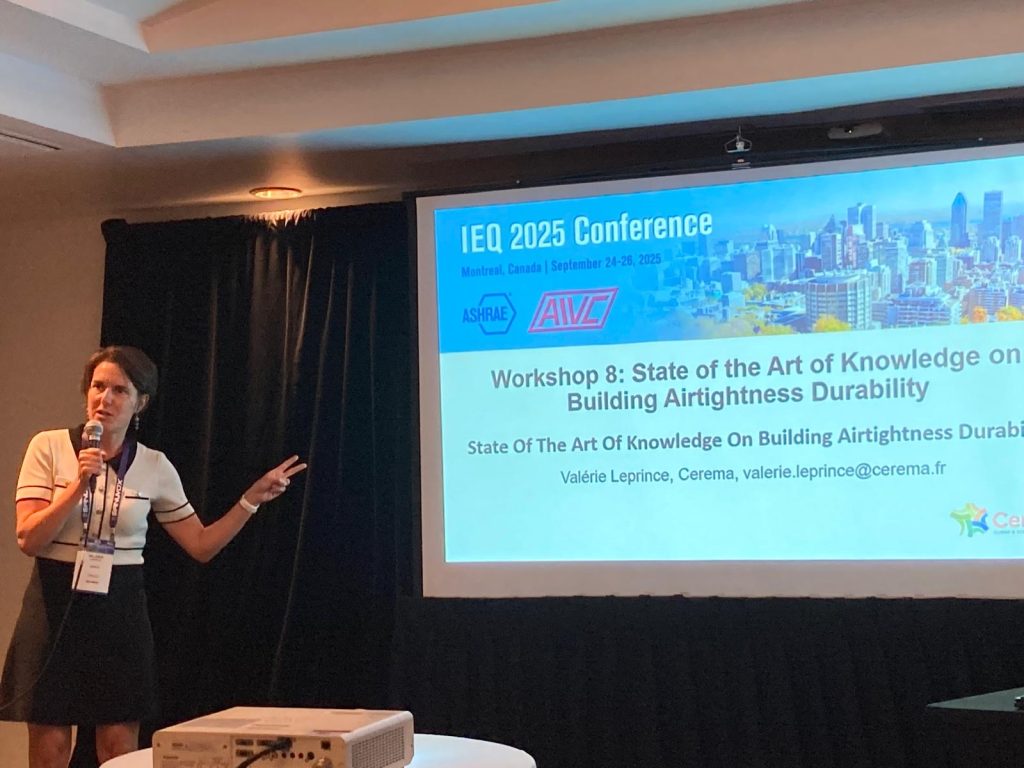Building Airtightness Durability: Durabilit’air 2 – Summary of the AIVC–ASHRAE IEQ 2025 Session
Driven by the goal of nearly zero energy buildings (nZEB) and regulations since the early 2000s, building airtightness has become a mandatory requirement for energy performance. However, the effectiveness of these requirements hinges on the durability of airtightness over the building’s lifespan. Current practices often involve last-minute sealing efforts, and the long-term integrity of products and assemblies is compromised by construction practices, building movement, and environmental conditions. This session, based on the Durabilit’air 2 project presented findings from both field measurements and accelerated laboratory aging tests.
The State of Knowledge and Research Gaps
The session opened with a state-of-the-art review on existing research, confirming significant progress in initial building airtightness but highlighting the insufficient understanding of its long-term durability. Field studies generally observe a pattern where airtightness levels tend to decrease during the first few years of a building’s life before stabilizing. Critically, the causes underlying these variations are rarely investigated in depth. Parallel laboratory aging studies reveal a fundamental lack of standardized protocols for assessing the long-term performance of airtightness product assemblies, pointing to the need for more rigorous and replicable testing methods. This knowledge deficit served as the core motivation for the subsequent, more detailed studies presented.
Field Observations: Understanding Early Airtightness Degradation
To isolate and understand the factors contributing to early-life degradation, a detailed field monitoring study was conducted on 10 newly constructed residential houses. Researchers meticulously followed the construction process, recording the application conditions of the airtightness layer and environmental parameters such as indoor surface dust levels, temperature, and humidity during installation. Airtightness was measured at commissioning and then repeatedly four to five times during the first year of occupancy.
The findings provided significant lessons regarding the impact of early implementation choices. A notable increase in air permeability (degradation of airtightness) was observed in several cases following the first heating period. This effect was most pronounced in houses where the airtightness layer was applied late in the construction cycle, particularly when relying on mastic sealing on plasterboard substrates, rather than an airtight layer integrated earlier into masonry. This underscores that the long-term performance of airtightness is influenced by the timing of application and the nature of the substrate. It seems that late-stage, mastic-based solutions show greater vulnerability to early thermal cycling and material movement. However, the study also concluded that definitively isolating the primary cause of degradation is challenging due to the complex interplay of multiple parameters, necessitating a much larger sample of buildings for conclusive results.
Reproducing On-Site Conditions in the Laboratory
A crucial limiting factor for the durability of adhesive-based airtightness products is the cleanliness of the substrate. International standards specify that surfaces must be clean, dry, stable, and free from dust for effective adhesion, while it is quite impossible to ensure dustyless surfaces in a construction site. To transition from general site observations to quantifiable lab-based research, a study was undertaken to develop a feasible on-site protocol for quantifying surface dust accumulation.
Three methods were reviewed for dust quantification: laser granulometry, visual contrast (NF X 50-792 standard), and weight measurement using adhesive tape sampling. The tape sampling and weighing method was selected for its practicality in a construction environment. Analysis of seventeen samples across various sites confirmed that this method is suitable for horizontal surfaces, which showed consistently measurable dust quantities. However, it proved less reliable for vertical surfaces, where measured dust masses were low and uncertainty was high, suggesting a need for procedural adjustments such as increasing the sample area. This protocol offers a necessary tool to quantify a key construction site variable—dust—that can be systematically replicated in controlled laboratory studies.
Laboratory Results: Quantifying the Impact of Dust and Temperature
The final presentation detailed an experimental campaign designed to replicate real-world dust and temperature implementation conditions in the laboratory to assess their impact on long-term performance. Three common airtightness junction configurations were tested under three controlled conditions: normal, cold, and dusty.
The experimental results demonstrated distinct performance trends based on the assembly type:
- Mastic-based assemblies (PVC/mastic/plasterboard and wood/mastic/plasterboard): These configurations exhibited greater overall degradation compared to membrane systems. Air permeability often doubled after accelerated aging, and tripled when the mastic was applied in cold conditions. Surprisingly, the initial airtightness of these joints was largely unaffected by dusty conditions, suggesting that dust’s negative impact on mastic is primarily a latent degradation factor over time.
- Membrane and adhesive systems (membrane/adhesive/wood): These systems were highly sensitive to poor implementation conditions initially. Cold application doubled the initial air permeability, while dusty conditions led to a dramatic, ninety-fold increase in initial permeability. However, following aging, joints applied under normal conditions remained stable, whereas those applied in the cold degraded significantly.
Conclusion and Implications
This session collectively demonstrated that the long-term durability of building airtightness is not solely a function of product quality but is critically dependent on environmental and procedural factors during installation, particularly the implementation method, temperature, and surface cleanliness (dusting). The studies confirmed that early degradation is a tangible reality and provide quantifiable data indicating that late-stage, mastic-based sealing and installation in cold or dusty conditions pose significant risks to long-term airtightness performance. These findings necessitate a critical review of on-site best practices and underscore the need for standardized lab protocols to reliably predict the long-term durability of sealing products under adverse, yet common, construction conditions.
For further information, the AIVC has published a Technical Note entitled Durability of Building Airtightness available here: https://www.aivc.org/resource/tn-71-durability-building-airtightness.
All publications related to Durabilit’air 1 and 2 projects will be available on the Durabilit’air website https://www.durabilitair.com/. This project has been funded by ADEME (the French Energy Agency) under the “Batiment Responsable” project.
Article by Valérie Leprince, Cerema, France

Valerie Leprince presenting during the ‘Durability of the Building Airtightness’ workshop at the 45th AIVC-ASHRAE
IEQ-TightVent & venticool Conference in Montreal.”
